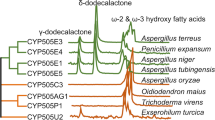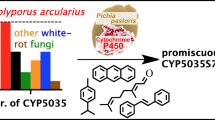Abstract
Several filamentous fungi are able to concomitantly assimilate both aliphatic and polycyclic aromatic hydrocarbons that are the biogenic by-products of some industrial processes. Cytochrome P450 monooxygenases catalyze the first oxidation reaction for both types of substrate. Among the cytochrome P450 (CYP) genes, the family CYP52 is implicated in the first hydroxylation step in alkane-assimilation processes, while genes belonging to the family CYP53 have been linked with oxidation of aromatic hydrocarbons. Here, we perform a comparative analysis of CYP genes belonging to clans CYP52 and CYP53 in Aspergillus niger, Beauveria bassiana, Metarhizium robertsii (formerly M. anisopliae var. anisopliae), and Penicillium chrysogenum. These species were able to assimilate n-hexadecane, n-octacosane, and phenanthrene, exhibiting a species-dependent modification in pH of the nutrient medium during this process. Modeling of the molecular docking of the hydrocarbons to the cytochrome P450 active site revealed that both phenanthrene and n-octacosane are energetically favored as substrates for the enzymes codified by genes belonging to both CYP52 and CYP53 clans, and thus appear to be involved in this oxidation step. Analyses of gene expression revealed that CYP53 members were significantly induced by phenanthrene in all species studied, but only CYP52X1 and CYP53A11 from B. bassiana were highly induced with n-alkanes. These findings suggest that the set of P450 enzymes involved in hydrocarbon assimilation by fungi is dependent on phylogeny and reveal distinct substrate and expression specificities.





Similar content being viewed by others
References
Al-Nasrawi, H. (2012). Biodegradation of crude oil by fungi isolated from Gulf of Mexico. Journal of Bioremediation & Biodegradation, 3, 147. https://doi.org/10.4172/2155-6199.1000147.
Colombo, J. C., Cabello, M., & Arambarri, A. M. (1996). Biodegradation of aliphatic and aromatic hydrocarbons by natural soil microflora and pure cultures of imperfect and lignolitic fungi. Environmental Pollution, 94, 355–362.
Harms, H., Schlosser, D., & Wick, L. Y. (2011). Untapped potential: exploiting fungi in bioremediation of hazardous chemicals. Nature Reviews Microbiology, 9, 177–192.
Silva, I. S., Santos, E. C., Menezes, C. R., Faria, A. F., Franciscon, E., Grossman, M., & Durrant, L. R. (2009). Bioremediation of a polyaromatic hydrocarbon contaminated soil by native soil microbiota and bioaugmentation with isolated microbial consortia. Bioresource Technology, 100, 4669–4675.
Hallsworth, J. E., & Magan, N. (1995). Manipulation of intracellular glycerol and erythritol enhances germination of conidia at low water availability. Microbiology, 141, 1109–1115.
Huarte-Bonnet, C., Juárez, M. P., & Pedrini, N. (2015). Oxidative stress in entomopathogenic fungi grown on insect-like hydrocarbons. Current Genetics, 61, 289–297.
Lovett, B., & St. Leger, R. J. (2014). Stress is the rule rather than the exception for Metarhizium. Current Genetics, 61, 253–261.
Rangel, D. E. N., Braga, G. U. L., Fernandes, É. K. K., Keyser, C. A., Hallsworth, J. E., & Roberts, D. W. (2015). Stress tolerance and virulence of insect-pathogenic fungi are determined by environmental conditions during conidial formation. Current Genetics, 61, 383–404.
Pedrini, N., Crespo, R., & Juárez, M. P. (2007). Biochemistry of insect epicuticle degradation by entomopathogenic fungi. Comparative Biochemistry and Physiology, 146C, 124–137.
Pedrini, N., Ortiz-Urquiza, A., Huarte-Bonnet, C., Zhang, S., & Keyhani, N. O. (2013). Targeting of insect epicuticular lipids by the entomopathogenic fungus Beauveria bassiana: hydrocarbon oxidation within the context of a host-pathogen interaction. Frontiers in Microbiology, 4, 24.
Pinedo-Rivilla, C., Aleu, J., & Collado, I. G. (2009). Pollutants biodegradation by fungi. Current Organic Chemistry, 13, 1194–1214.
Romero, M. C., Urrutia, M. I., Reinoso, H. E., & Moreno-Kiernan, M. (2010). Benzo[a]pyrene degradation by soil filamentous fungi. Journal of Yeast and Fungal Research, 1, 25–29.
Jerina, D. M., Kaubisch, N., & Daly, J. W. (1971). Arene oxides as intermediates in the metabolism of aromatic substrates: alkyl and oxygen migrations during isomerization of alkylated arene oxides. Proceedings of the National Academy of Sciences of the United States of America, 68, 2545–2548.
Lebeault, J. M., Lode, E. T., & Coon, M. J. (1971). Fatty acid and hydrocarbon hydroxylation in yeast: role of cytochrome P450 in Candida tropicalis. Biochemical and Biophysical Research Communications, 42, 413–419.
Zhang, S., Widemann, E., Bernard, G., Lesot, A., Pinot, F., Pedrini, N., & Keyhani, N. O. (2012). CYP52X1, representing new cytochrome P450 subfamily, displays fatty acid hydroxylase activity and contributes to virulence and growth on insect cuticular substrates in entomopathogenic fungus Beauveria bassiana. Journal of Biological Chemistry, 287, 13477–13486.
Novak, M., Lah, L., Šala, M., Stojan, J., Bohlmann, J., & Komel, R. (2015). Oleic acid metabolism via a conserved cytochrome P450 system-mediated ω-hydroxylation in the bark beetle-associated fungus Grosmannia clavigera. PloS One, 10(3), e0120119.
Tanaka, A., & Fukui, S. (1989). Metabolism of n-alkanes. In A. Tanaka & S. Fukui (Eds.), The yeast, 2nd edition (Vol. 3, pp. 261–287). New York: Academic Press.
Nelson, D. R. (2009). The cytochrome P450 homepage. Human Genomics, 4, 59–65.
Chen, W., Lee, M.-K., Jefcoate, C., Kim, S.-C., Chen, F., & Yu, J.-H. (2014). Fungal cytochrome P450 monooxygenases: their distribution, structure, functions, family expansion, and evolutionary origin. Genome Biology and Evolution, 6(7), 1620–1634.
Jawallapersand, P., Mashele, S. S., Kovacic, L., Stojan, J., Komel, R., Pakala, S. B., Krasevec, N., & Syed, K. (2014). Cytochrome P450 monooxygenase CYP53 family in fungi: comparative structural and evolutionary analysis and its role as a common alternative anti-fungal drug target. PloS One, 9(9), e107209.
Craft, D. L., Madduri, K. M., Eshoo, M., & Wilson, C. R. (2003). Identification and characterization of the CYP52 family of Candida tropicalis ATCC 20336, important for the conversion of fatty acids and alkanes to α,ω-dicarboxylic acids. Applied and Environmental Microbiology, 69, 5983–5991.
Faber, B. W., van Gorcom, R. F. M., & Duine, J. A. (2001). Purification and characterization of benzoate-para-hydroxylase, a cytochrome P450 (CYP53A1), from Aspergillus niger. Archives of Biochemistry and Biophysics, 394, 245–254.
Harwood, C. S., & Parales, R. E. (1996). The beta-ketoadipate pathway and the biology of self-identity. Annual Review of Microbiology, 50, 553–590.
Moktali, V., Park, J., Fedorova-Abrams, N. D., Park, B., Choi, J., Lee, Y.-H., & Kang, S. (2012). Systematic and searchable classification of cytochrome P450 proteins encoded by fungal and oomycete genomes. BMC Genomics, 13, 525.
Bischoff, J. F., Rehner, S. A., & Humber, R. A. (2009). A multilocus phylogeny of the Metarhizium anisopliae lineage. Mycologia, 101(4), 512–530.
Kelley, L. A., Mezulis, S., Yates, C. M., Wass, M. N., & Sternberg, M. J. E. (2015). The Phyre2 web portal for protein modeling, prediction and analysis. Nature Protocols, 10, 845–858.
Pfaffl, M. W., Horgan, G. W., & Dempfle, L. (2002). Relative expression software tool (REST) forgroup-wise comparison and statistical analysis of relative expression results in real-time PCR. Nucleic Acids Research, 30(9), e36.
Cray, J. A., Stevenson, A., Ball, P., Bankar, S. B., Eleutherio, E. C. A., Ezeji, T. C., et al. (2015). Chaotropicity: a key factor in product tolerance of biofuel-producing microorganisms. Current Opinion in Biotechnology, 33, 228–259.
McCammick, E. M., Gomase, V. S., Timson, D. J., McGenity, T. J., & Hallsworth, J. E. (2010). Water-hydrophobic compound interactions with the microbial cell. In K. N. Timmis (Ed.), Handbook of hydrocarbon and lipid microbiology–hydrocarbons, oils and lipids: Diversity, properties and formation (Vol. 2, pp. 1451–1466). New York: Springer.
Ball, P., & Hallsworth, J. E. (2015). Water structure and chaotropicity: their used, abuses and implications for biology. Physical Chemistry Chemical Physics, 17, 8297–8305.
Lobo, L. S., Luz, C., Fernandes, E. K. K., Juárez, M. P., & Pedrini, N. (2015). Assessing gene expression during pathogenesis: use of qRT-PCR to follow toxin production in the entomopathogenic fungus Beauveria bassiana during infection and immune response of the insect host Triatoma infestans. Journal of Invertebrate Pathology, 128, 14–21.
Roberts, D. W., Gupta, S., & St. Leger, R. J. (1992). Metabolite production by entomopathogenic fungi. Pesquisa Agropecuária Brasileira, 27, 325–347.
Kirkland, B. H., Eisa, A., & Keyhani, N. O. (2005). Oxalic acid as a fungal acaracidal virulence factor. Journal of Medical Entomology, 42, 346–351.
Pedrini, N., Zhang, S., Juárez, M. P., & Keyhani, N. O. (2010). Molecular characterization and expression analysis of a suite of cytochrome P450 enzymes implicated in insect hydrocarbon degradation in the entomopathogenic fungus Beauveria bassiana. Microbiology, 156, 2549–2557.
Gao, Q., Jin, K., Yin, S. H., Zhang, Y., Xiao, G., Shang, Y., Duan, Z., Hu, X., Xie, X. Q., Zhou, G., et al. (2011). Genome sequencing and comparative transcriptomics of the model entomopathogenic fungi Metarhizium anisopliae and M. acridum. PLoS Genetics, 7(1), e1001264.
Mendonça, A. L., da Silva, C. E., de Mesquita, F. L., Campos, R. S., do Nascimento, R. R., Ximenes, E. C., & Santana, A. E. (2009). Antimicrobial activities of components of the glandular secretions of leaf cutting ants of the genus Atta. Antonie Van Leeuwenhoek, 95, 295–303.
Lin, L., Fang, W., Liao, X., Wang, F., Wei, D., et al. (2011). The MrCYP52 cytochrome P450 monoxygenase gene of Metarhizium robertsii is important for utilizing insect epicuticular hydrocarbons. PloS One, 6(12), e28984.
Halo, L. M., Heneghan, M. N., Yakasai, A. A., Song, Z., Williams, K., Bailey, A. M., Cox, R. J., Lazarus, C. M., & Simpson, T. J. (2008). Late stage oxidations during the biosynthesis of the 2-pyridone tenellin in the entomopathogenic fungus Beauveria bassiana. Journal of the American Chemical Society, 130(52), 17988–17996.
Yadav, J. S., Soellner, M. B., Loper, J. C., & Mishra, P. K. (2003). Tandem cytochrome P450 monooxygenase genes and splice variants in the white rot fungus Phanerochaete chrysosporium: cloning, sequence analysis, and regulation of differential expression. Fungal Genetics and Biology, 38, 10–21.
Doddapaneni, H., & Yadav, J. S. (2004). Differential regulation and xenobiotic induction of tandem P450 monooxygenase genes pc-1 (CYP63A1) and pc-2 (CYP63A2) in the white rot fungus Phanerochaete chrysosporium. Applied Microbiology and Biotechnology, 65, 559–565.
Doddapaneni, H., Subramanian, V., & Yadav, J. S. (2005). Physiological regulation, xenobiotic induction, and heterologous expression of P450 monooxygenase gene pc-3 (CYP63A3), a new member of CYP63 gene cluster in the white rot fungus Phanerochaete chrysosporium. Current Microbiology, 50, 292–298.
Syed, K., Porollo, A., Lam, Y. W., Grimmett, P. E., & Yadav, J. S. (2013). CYP63A2, a catalytically versatile fungal P450 monooxygenase capable of oxidizing higher molecular-weight polycyclic aromatic hydrocarbons, alkylphenols, and alkanes. Applied and Environmental Microbiology, 79, 2692–2702.
Reyes-César, A., Absalón, Á. E., Fernández, F. J., González, J. M., & Cortés-Espinosa, D. V. (2014). Biodegradation of a mixture of PAHs by non-ligninolytic fungal strains isolated from crude oil-contaminated soil. World Journal of Microbiology and Biotechnology, 30, 999–1009.
Zafra, G., Absalón, Á. E., Cuevas, M. C., & Cortés-Espinosa, D. V. (2014). Isolation and selection of a highly tolerant microbial consortium with potential for PAH biodegradation from heavy crude oil-contaminated soils. Water, Air, and Soil Pollution, 225, 1826.
Liao, X., O’Brien, T. R., Fang, W., & St. Leger, R. J. (2014). The plant beneficial effects of Metarhizium species correlate with their association with roots. Applied Microbiology and Biotechnology, 98, 7089–7096.
Behie, S. W., Zelisko, P. M., & Bidochka, M. J. (2012). Endophytic insect-parasitic fungi translocate nitrogen directly from insects to plants. Science, 336(6088), 1576–1577.
Cray, J. A., Bell, A. N. W., Bhaganna, P., Mswaka, A. Y., Timson, D. J., & Hallsworth, J. E. (2013). The biology of habitat dominance; can microbes behave as weeds? Microbial Biotechnology, 6(5), 453–492.
Paulussen, C., Hallsworth, J. E., Álvarez-Pérez, S., Nierman, W. C., Hamill, P. G., et al. (2017). Ecology of aspergillosis: insights into the pathogenicity of Aspergillus fumigatus and some other Aspergillus species. Microbial Biotechnology, 10, 296–322.
Acknowledgements
We thank C. Lopez Lastra for kindly providing the M. anisopliae isolate CEP 120 used in this study. We also thank Juan Cruz Ponce for the experimental assistance.
Funding
This research was partially supported by CONICET (PIP 112 20110100391) to MCNS and ANPCyT (PICT 2012 1964) to NP. MCNS, JRG, and NP are members of the CONICET Researcher’s Career, Argentina.
Author information
Authors and Affiliations
Corresponding author
Rights and permissions
About this article
Cite this article
Huarte-Bonnet, C., Kumar, S., Saparrat, M.C.N. et al. Insights into Hydrocarbon Assimilation by Eurotialean and Hypocrealean Fungi: Roles for CYP52 and CYP53 Clans of Cytochrome P450 Genes. Appl Biochem Biotechnol 184, 1047–1060 (2018). https://doi.org/10.1007/s12010-017-2608-z
Received:
Accepted:
Published:
Issue Date:
DOI: https://doi.org/10.1007/s12010-017-2608-z




